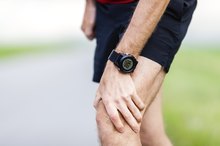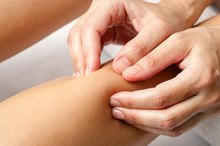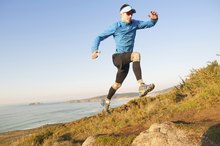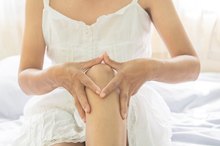Leg Pain Below the Knee
Leg pain can strike anytime. Specific pain below the knee may be caused by factors such as anatomical weakness, daily activity and stress, and individual levels of fitness. The entire knee joint is susceptible to accidents and overuse, so knowing the exact cause of pain is helpful in controlling it.
If you are experiencing serious medical symptoms, seek emergency treatment immediately.
Anatomy
The area of the leg directly below the knee includes tendons, ligaments and bone. Because there are few stabilizing structures and relatively little subcutaneous fat in this area, the tissues can be easily injured. Directly below the knee cap are the thick patellar tendons and ligaments that attach to the heads of the two shinbones, the tibia and fibula. Small amounts of cartilage, including a moon-shaped meniscus slightly below and to the inside of each knee, provide cushioning. Add a bunch of blood vessels and nerves and you have lots of anatomical pieces that can get hit, twisted or pinched, with pain sometimes radiating down the leg.
- The area of the leg directly below the knee includes tendons, ligaments and bone.
- Small amounts of cartilage, including a moon-shaped meniscus slightly below and to the inside of each knee, provide cushioning.
Direct Forces and Twisting
Pain With Running on Hard Surfaces
Learn More
Direct impact injuries include being struck in the knee or leg by an object such as a rock, you and a soccer teammate colliding at the knees, or a football player tackling another sideways at knee-level. Impact forces bruise and crack tissue, even bone, on a continuum from the tiniest strain or hairline crack to a full tearing of tissue or breakage of bone. Soccer, football, tennis and skiing also incur twisting forces that injure knee and leg tissue directly.
Running and Overuse
Running can either help or harm your lower legs 1. Studies reported by the New York Times have shown that running can actually protect your knees because it strengthens the leg's muscles, tendons and ligaments, stabilizing the knee joint and absorbing the repetitive pounding forces 1. Strong leg muscles and connective tissues protect your bones from stress fractures. However, when these protective structures tire from overuse, leg pain can quickly set in. Leg muscles can also become injured via sprains, strains, sudden increases in mileage or between running surfaces.
- Running can either help or harm your lower legs 1.
- However, when these protective structures tire from overuse, leg pain can quickly set in.
Swimming with Faulty Technique
Pain Above the Knee Cap With Running
Learn More
Errors in training techniques account for most swimmers' lower leg pain. One injury in particular seems to befall breast-strokers: medial collateral ligament (MCL) tendinitis 2. Physio Advisor suggests that MCL tendinitis arises gradually from the frog-kick's repetitive propulsion, which requires the quadriceps and hamstring muscles to whip the lower legs backwards and together. This snapping action forces the knees to rotate in the water, stressing the MCL. If you frog-kick with too much snap and twist, you may get tendinitis. And if you fail to rest your legs after intense workouts, you risk injury from over-training.
- Errors in training techniques account for most swimmers' lower leg pain.
- Physio Advisor suggests that MCL tendinitis arises gradually from the frog-kick's repetitive propulsion, which requires the quadriceps and hamstring muscles to whip the lower legs backwards and together.
Age and Deterioration
As you age, your legs lose strength, pains can become chronic and injuries take longer to heal. Arthritis, diabetes and nerve degeneration can lead to daily lower leg pain, so practice preventive measures such as regular exercise, good nutrition and sufficient sleep. According to American Family Physician, walking, running and cycling improve lower leg muscle tone, bone resilience and blood circulation. Adequate intake of protein and anti-inflammatory essential fatty acids found in fish, walnuts and olive oil can all potentially minimize muscle damage.
- As you age, your legs lose strength, pains can become chronic and injuries take longer to heal.
- According to American Family Physician, walking, running and cycling improve lower leg muscle tone, bone resilience and blood circulation.
Related Articles
References
- New York Times: Well Blog; Phys Ed--Can Running Actually Help Your Knees?
- American Family Physician: Promoting and Prescribing Exercise for the Elderly
- Lespasio MJ, Piuzzi NS, Husni ME, Muschler GF, Guarino A, Mont MA. Knee Osteoarthritis: A Primer. Perm J. 2017;21:16-183. doi:10.7812/TPP/16-183
- Kiapour AM, Murray MM. Basic science of anterior cruciate ligament injury and repair. Bone Joint Res. 2014;3(2):20-31. doi:10.1302/2046-3758.32.2000241
- Doral MN, Bilge O, Huri G, Turhan E, Verdonk R. Modern treatment of meniscal tears. EFORT Open Rev. 2018;3(5):260-268. doi:10.1302/2058-5241.3.170067
- Reinking MF. CURRENT CONCEPTS IN THE TREATMENT OF PATELLAR TENDINOPATHY. Int J Sports Phys Ther. 2016;11(6):854-866.
- Petersen W, Rembitzki I, Liebau C. Patellofemoral pain in athletes. Open Access J Sports Med. 2017;8:143-154. doi:10.2147/OAJSM.S133406
- Frush TJ, Noyes FR. Baker's Cyst: Diagnostic and Surgical Considerations. Sports Health. 2015;7(4):359-65. doi:10.1177/1941738113520130
- Huang YC, Yeh WL. Endoscopic treatment of prepatellar bursitis. Int Orthop. 2011;35(3):355-8. doi:10.1007/s00264-010-1033-5
- Beals C, Flanigan D. A Review of Treatments for Iliotibial Band Syndrome in the Athletic Population. J Sports Med (Hindawi Publ Corp). 2013;2013:367169. doi:10.1155/2013/367169
- Tsai CH, Hsu CJ, Hung CH, Hsu HC. Primary traumatic patellar dislocation. J Orthop Surg Res. 2012;7:21. doi:10.1186/1749-799X-7-21
- Ragab G, Elshahaly M, Bardin T. Gout: An old disease in new perspective - A review. J Adv Res. 2017;8(5):495-511. doi:10.1016/j.jare.2017.04.008
- Lee PYF, Nixion A, Chandratreya A, Murray JM. Synovial Plica Syndrome of the Knee: A Commonly Overlooked Cause of Anterior Knee Pain. Surg J (N Y). 2017;3(1):e9-e16. doi:10.1055/s-0037-1598047
- Vaishya R, Azizi AT, Agarwal AK, Vijay V. Apophysitis of the Tibial Tuberosity (Osgood-Schlatter Disease): A Review. Cureus. 2016;8(9):e780. doi:10.7759/cureus.780
- Zanon G, Di vico G, Marullo M. Osteochondritis dissecans of the knee. Joints. 2014;2(1):29-36.
- Hindle P, Davidson E, Biant LC. Septic arthritis of the knee: the use and effect of antibiotics prior to diagnostic aspiration. Ann R Coll Surg Engl. 2012;94(5):351-5. doi:10.1308/003588412X13171221591015
- Gwinner C, Märdian S, Schwabe P, Schaser KD, Krapohl BD, Jung TM. Current concepts review: Fractures of the patella. GMS Interdiscip Plast Reconstr Surg DGPW. 2016;5:Doc01. doi:10.3205/iprs000080
- Voskuil R, Evenski AJ, Montgomery C, Emory CL. Malignant Bone Tumors of the Knee: How to Identify and Treat. J Knee Surg. 2019;32(4):305-314. doi:10.1055/s-0038-1675828
- Gupte C, St mart JP. The acute swollen knee: diagnosis and management. J R Soc Med. 2013;106(7):259-68. doi:10.1177/0141076813482831
- American Academy of Orthopedic Surgeons. Unstable Kneecap.
- Bhatia D, Bejarano T, Novo M. Current interventions in the management of knee osteoarthritis. Journal of Pharmacy & Bioallied Sciences 2013 Jan-Mar;5(1):30-38. doi:%2010.4103/0975-7406.106561
- Bronstein RD, Schaffer JC. Physical Examination of the Knee: Meniscus, Cartilage, and Patellofemoral Conditions. J Am Acad Orthop Surg. 2017 May;25(5):365-374.
- Browne K, Kurtz CA. How to perform a comprehensive examination of the knee. JAAPA. 2009 Jun;22(6):20-25.
- Hergenroeder AC, Harvey BS. (2017). Osteochondritis dissecans (OCD): Clinical manifestations and diagnosis. Bachur RG, ed. UpToDate. Waltham, MA: UpToDate Inc.
Resources
Writer Bio
Based in New York City, Fiona Bayly writes about running with a focus on health, nutrition and training strategies for athletes from beginner to professional. She is an avid triathlete, former New England Scholastic Cross Country champion and current member of TeamUSA's age-group championship team in the sport of Aquathlon.








